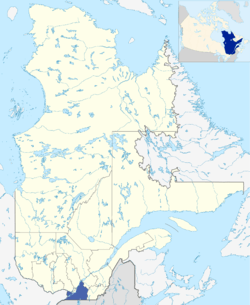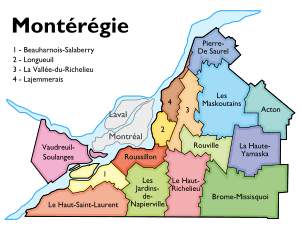Montérégie
Montérégie (French pronunciation: [mɔ̃teʁeʒi]) is an administrative region in the southwest part of Quebec. It includes the cities of Boucherville, Brossard, Granby, Longueuil, Salaberry-de-Valleyfield, Saint-Jean-sur-Richelieu, Saint-Hyacinthe, Sorel-Tracy, and Vaudreuil-Dorion.
Montérégie | |
|---|---|
 | |
| Coordinates: 45°23′N 73°06′W | |
| Country | |
| Province | |
| Regional County Municipalities (RCM) and Equivalent Territories (ET) | 14 RCM, 1 ET |
| Area | |
| • Total | 11,851 km2 (4,576 sq mi) |
| • Land | 11,132.34 km2 (4,298.22 sq mi) |
| Population | |
| • Total | 1,507,070 |
| • Density | 135.4/km2 (351/sq mi) |
| Demonym(s) | Montérégien(ne) |
| Time zone | UTC-5 (EST) |
| • Summer (DST) | UTC-4 (EDT) |
| Postal code | J |
| Area code | 450, 579 |
| Website | monteregie.gouv.qc.ca |
| [2] | |
The region had a population of 1,507,070 as of the 2016 census and a land area of 11,132.34 square kilometres (4,298.22 sq mi), giving it a population density of 135.4 inhabitants/km2.[1] With approximately 18.5% of the province's population, it is the second most populous region of Quebec after Montreal. The majority of the population lives near the Saint Lawrence River, on the south shore of Montreal.
Montérégie is known for its vineyards, orchards, panoramas, delicious products, and the Monteregian mountains. The region is both urban (second in terms of population in Quebec) and rural. The regional economy is based on agriculture and the production of goods and services. Tourism also makes up a significant portion of the economy.
History
Jacques Cartier named Mont Royal in October 1535.[3] Samuel de Champlain built several forts to protect the colonists against the Iroquois and against the English, who were colonizing New England, to the southeast.
The toponym comes from the latinized form of Mount Royal, mons regius. Montérégie is named for the Monteregian Hills, which are, in turn, named for Mont Royal (English: Mount Royal).
The term for naming the set of hills in the St. Lawrence Plain was originally created in 1903 in English by geologist Frank Dawson Adams to designate a new petrographic province.
Mount Royal on Montreal Island, although outside the Montérégie region, is one of the Monteregian Hills. In addition to Mount Royal, two other Montérégie hills are not located in Montérégie: Mount Mégantic, in Estrie, and the hills of Oka, in the Lower Laurentians.
Montérégie was populated by the Iroquois when the French began to colonize here in the beginning of the 17th century.
Some of the battles which decided the destiny of Canada took place in Montérégie. In the 1837s, patriots rebelled against British government troops.[4] The Province of Canada (also called a United Canada (French: Canada-Uni) was formed through the Union Act in 1840 and February 184, from the former provinces of Bas-Canada (Lower Canada) and Upper Canada.
Originally, the administrative territory of the Montérégie parishes were taken from the territory of the canonical Diocese of Saint-Jean-Longueuil.
Subregions
The Montérégie comprises three administrative subregions, each consisting of its own Regional County Municipalities (RCM) or Equivalent Territories. The territorial administration of the region is conducted by three Regional Conferences of Elected Officers (French: Conférences régionales des élus) (CRE) separate and independent in their territory: Longueuil, Montérégie-Est (eastern RCMs) and Vallée-du-Haut-Saint-Laurent (western RCMs). Each sub-region is organized in the same way as other administrative regions of Quebec.
Montérégie Est
There are nine RCMs in Montérégie Est. Its seat is McMasterville, and the president is Arthur Fauteux. Its territory occupies 7,122.92 square kilometres (2,750.17 sq mi) and there are 656,287 inhabitants, with a population density of 92.1/km2 (238.6/sq mi).
| Regional County Municipality (RCM) | Population Canada 2016 Census[5] |
Land Area | Density (pop. per km2) |
Seat of RCM |
|---|---|---|---|---|
| Acton | 15,594 | 579.80 km2 (223.86 sq mi) | 26.9 | Acton Vale |
| Brome-Missisquoi | 58,314 | 1,652.08 km2 (637.87 sq mi) | 35.3 | Cowansville |
| La Haute-Yamaska | 88,306 | 636.81 km2 (245.87 sq mi) | 138.7 | Granby |
| La Vallée-du-Richelieu | 124,420 | 588.60 km2 (227.26 sq mi) | 211.4 | McMasterville |
| Le Haut-Richelieu | 117,443 | 936.02 km2 (361.40 sq mi) | 125.5 | Saint-Jean-sur-Richelieu |
| Les Maskoutains | 87,099 | 1,302.90 km2 (503.05 sq mi) | 66.9 | Saint-Hyacinthe |
| Marguerite-D'Youville (formerly Lajammerais until January 2011) |
77,550 | 346.04 km2 (133.61 sq mi) | 224.1 | Verchères |
| Pierre-De Saurel (formerly La Bas-Richelieu until January 2009) |
51,025 | 597.55 km2 (230.72 sq mi) | 85.4 | Sorel-Tracy |
| Rouville | 36,536 | 483.12 km2 (186.53 sq mi) | 75.6 | Marieville |
Vallée-du-Haut-Saint-Laurent
There are five RCMs in Vallée-du-Haut-Saint-Laurent. Its seat is Salaberry-de-Valleyfield, and its president is Yves Daoust. Its territory occupies 3,727.22 square kilometres (1,439.09 sq mi) and there are 435,436 inhabitants, with a population density of 116.8/km2 (302.6/sq mi).
| Regional County Municipality (RCM) | Population Canada 2016 Census[5] |
Land Area | Density (pop. per km2) |
Seat of RCM |
|---|---|---|---|---|
| Beauharnois-Salaberry | 64,320 | 471.26 km2 (181.95 sq mi) | 136.5 | Beauharnois |
| Le Haut-Saint-Laurent | 22,454 | 1,173.51 km2 (453.09 sq mi) | 19.1 | Huntingdon |
| Les Jardins-de-Napierville | 27,870 | 803.07 km2 (310.07 sq mi) | 34.7 | Napierville |
| Roussillon | 171,443 | 423.82 km2 (163.64 sq mi) | 404.5 | Saint-Constant |
| Vaudreuil-Soulanges | 149,349 | 855.56 km2 (330.33 sq mi) | 174.6 | Vaudreuil-Dorion |
Equivalent territory
| Equivalent Territory (ET) | Population Canada 2016 Census[5] |
Land Area | Density (pop. per km2) |
Seat of ET |
|---|---|---|---|---|
| Agglomeration of Longueuil | 415,347 | 282.21 km2 (108.96 sq mi) | 1,471.80 | Longueuil |
Native Reserves
The population of both of these reserves are majority-Mohawk, one of the historic Five Nations of the Haudenosaunee, or Iroquois League. Kahnawake was established south of Montreal in 1719 as a mission village. Akwesasne was established upriver by Mohawk leaders and their families in the mid-18th century, accompanied by French Jesuit missionaries. Akwesasne spans the boundaries of Canada and the United States, extending across the St. Lawrence River into New York State, where it is referred to as the St. Regis Reservation.
Major communities
- Longueuil
- Mont-Saint-Hilaire
- Pincourt
- Saint-Basile-le-Grand
- Saint-Bruno-de-Montarville
- Saint-Constant
- Saint-Hyacinthe
- Saint-Jean-sur-Richelieu
References
- "Census Profile, 2016 Census: Montérégie [Economic region], Quebec". Statistics Canada. Retrieved November 24, 2019.
- The Voyages of Jacques Cartier [Original Diary]. By H.P. Biggar. F.A. Acland Printer to the King's Most Excellent Majesty: Ottawa 1924. p.155
- Solange Hamel. Les patriotes oubliés de la Montérégie, 1837, Saint-Alphonse-de-Granby : Éditions de la Paix, 2003, 129 pages (ISBN 2-922565-88-2).
- "Population and Dwelling Count Highlight Tables, 2016 Census". Statistics Canada. Retrieved November 26, 2019.
External links
| Wikimedia Commons has media related to Cities and towns of Montérégie. |
| Wikivoyage has a travel guide for Montérégie. |
- Portail régional de la Montérégie Official website (in French)
- Site officiel de la CRÉ de Longueuil (in French)
- Site officiel de la CRÉ de la Montérégie-Est (in French)
- Site officiel de la CRÉ de la Vallée-du-Haut-Saint-Laurent (in French)
- Agence de la santé et des services sociaux de la Montérégie (in French)
